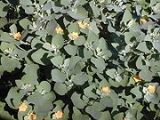
Sida fallax
Encyclopedia
Sida fallax, known as ilima in Hawaiian
, is a species of herbaceous
flowering plant
in the Hibiscus
family, Malvaceae
, that occurs on most of the Pacific Islands
. The flower
s are small, 0.75–1 in (1.9–2.5 cm) in diameter, have five petals, and are a golden yellow in color. Plants may be erect or prostrate and are found in drier areas in sand
y soil
s, often near the ocean. Ilima is the symbol of Laloimehani and is the flower for the island of Oahu
.
used ilima flowers to make lei
. S. fallax is sometimes used as a groundcover
in tropical areas.
|work=Native Hawaiian Plants |publisher=Kapiolani Community College
|accessdate=}}
Hawaiian language
The Hawaiian language is a Polynesian language that takes its name from Hawaii, the largest island in the tropical North Pacific archipelago where it developed. Hawaiian, along with English, is an official language of the state of Hawaii...
, is a species of herbaceous
Herbaceous plant
A herbaceous plant is a plant that has leaves and stems that die down at the end of the growing season to the soil level. They have no persistent woody stem above ground...
flowering plant
Flowering plant
The flowering plants , also known as Angiospermae or Magnoliophyta, are the most diverse group of land plants. Angiosperms are seed-producing plants like the gymnosperms and can be distinguished from the gymnosperms by a series of synapomorphies...
in the Hibiscus
Hibiscus
Hibiscus is a genus of flowering plants in the mallow family, Malvaceae. It is quite large, containing several hundred species that are native to warm-temperate, subtropical and tropical regions throughout the world...
family, Malvaceae
Malvaceae
Malvaceae, or the mallow family, is a family of flowering plants containing over 200 genera with close to 2,300 species. Judd & al. Well known members of this family include okra, jute and cacao...
, that occurs on most of the Pacific Islands
Pacific Islands
The Pacific Islands comprise 20,000 to 30,000 islands in the Pacific Ocean. The islands are also sometimes collectively called Oceania, although Oceania is sometimes defined as also including Australasia and the Malay Archipelago....
. The flower
Flower
A flower, sometimes known as a bloom or blossom, is the reproductive structure found in flowering plants . The biological function of a flower is to effect reproduction, usually by providing a mechanism for the union of sperm with eggs...
s are small, 0.75–1 in (1.9–2.5 cm) in diameter, have five petals, and are a golden yellow in color. Plants may be erect or prostrate and are found in drier areas in sand
Sand
Sand is a naturally occurring granular material composed of finely divided rock and mineral particles.The composition of sand is highly variable, depending on the local rock sources and conditions, but the most common constituent of sand in inland continental settings and non-tropical coastal...
y soil
Soil
Soil is a natural body consisting of layers of mineral constituents of variable thicknesses, which differ from the parent materials in their morphological, physical, chemical, and mineralogical characteristics...
s, often near the ocean. Ilima is the symbol of Laloimehani and is the flower for the island of Oahu
Oahu
Oahu or Oahu , known as "The Gathering Place", is the third largest of the Hawaiian Islands and most populous of the islands in the U.S. state of Hawaii. The state capital Honolulu is located on the southeast coast...
.
Uses
Native HawaiiansNative Hawaiians
Native Hawaiians refers to the indigenous Polynesian people of the Hawaiian Islands or their descendants. Native Hawaiians trace their ancestry back to the original Polynesian settlers of Hawaii.According to the U.S...
used ilima flowers to make lei
Lei (Hawaii)
Lei is a Hawaiian word for a garland or wreath. More loosely defined, a lei is any series of objects strung together with the intent to be worn. The most popular concept of a lei in Hawaiian culture is a wreath of flowers draped around the neck presented upon arriving or leaving as a symbol of...
. S. fallax is sometimes used as a groundcover
Groundcover
Groundcover refers to any plant that grows over an area of ground, used to provide protection from erosion and drought, and to improve its aesthetic appearance .- Ecosystem :...
in tropical areas.
External links
|work=Native Hawaiian Plants |publisher=Kapiolani Community College
Kapiolani Community College
Kapiolani Community College, formerly Kapiolani Technical School, is a public, co-educational commuter college in Honolulu, Hawaii situated on the slopes of Diamond Head in Waikīkī...
|accessdate=}}

